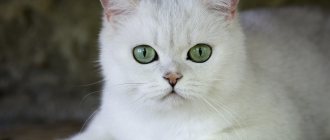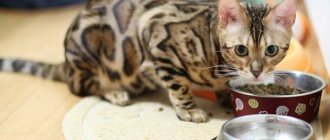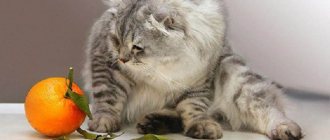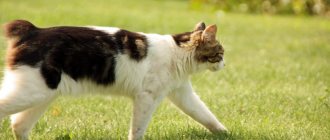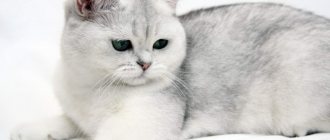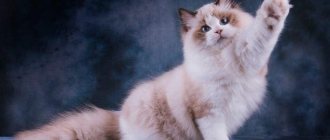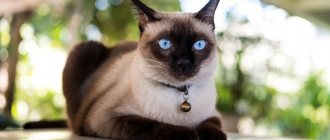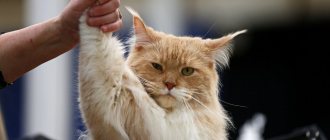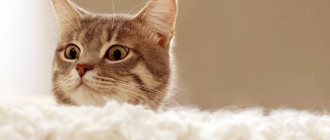Luxurious beauties - cats with white fur, the dream of a large number of people and pet lovers. According to standards, a cat's coat should not have any spots, stripes or other shades. When a white cat is still a small kitten, it is acceptable for there to be small markings on the face or body that disappear as the cat matures.
The white color of the coat is due to the complete absence of a specific coloring pigment - melanin. There are several reasons for the appearance of cats with white fur. Experts in the field of genetics identify 3 main factors - albinism, white spotting and dominance of the white gene.
There are many breeds of cats with white color. When choosing a pet with this color, it is important to remember that when caring for the coat, you must follow a number of rules. And then the furry pet will delight the eye.
Origin of snow color
It is simply impossible not to notice the snow-white cat among his brothers. This angelic creature attracts the attention and wins the hearts of even those people who do not consider themselves cat lovers. There is a certain magic in snow-white cats. Perhaps the reason lies in the genes of the pet.
A kitten most often inherits its snow-white color from its parents.
Pigmentation of an animal's fur occurs long before it is born. Even at the stage of embryo formation, pigment cells are formed in its nerve fibers. They are not yet able to color their fur. These cells acquire their main function already on the way to the hair follicles. At this same stage, pigment cells are modified under the influence of genes inherited from the kitten’s parents. It is this “inheritance” that determines the color, location of spots on the body and their shape.
It is possible to determine which gene was responsible for the cat’s color only through further crossing.
However, it also happens that during the transformation some cells lose the ability to produce pigment. This is how kittens with white points are born - in “socks”, with a “shirt front” or with a snow-colored belly.
It also happens that absolutely all the cells decide to “rest” and not dye the fur in any of the colors. One insidious gene sends them on vacation - W. Having appeared in the genotype, W suppresses all other colors, coming to the fore. This is how snow-white kittens are born. For example, the genotype BBOoSsddWw will belong to a kitten with colorless fur, despite the presence of color genes.
It is quite easy to identify an albino kitten: its eyes will not have a blue tint.
If we are not talking about albinism, then white is not considered a color. Strictly speaking, this is its complete absence. But the offspring of such an animal will not necessarily be white. If the cub does not inherit the W gene, its coat will be colored. Based on this pattern, geneticists claim that a snow-white kitten can appear if one of its parents was completely bleached by the same gene.
A kitten can become white, despite the fact that its genetic code will contain other colors
There is another option for the development of events. In addition to W, the S gene is responsible for the light color of the coat - the key to spotted coat. Appearing in the chain, the element gives the animal snow marks. It happens that S “captures” a large area. Then the whole cat is painted with one white spot, although its genetic code may contain other colors.
Myths about white cats
Humanity is favorable to felines. In all centuries, people have treated black cats with special reverence. They became heroes of myths, fairy tales, and were even endowed with magical powers. However, not only the coal beauties were destined to gain fame, but also their complete opposites - snow cats, who also have their own entertaining stories.
Myth No. 1. Deafness
Rumors about the deafness of snow-white cats are not groundless. And geneticists themselves are in no hurry to debunk this myth. The fact is that cases of hearing pathologies among colorless cats are quite common.
White cats can also inherit deafness from parents of different colors.
The reason for this is the W gene, already familiar to us from the previous chapter. In addition to snow-white fur and blue eyes, this element of the genetic chain leads to congenital deafness. In 40% of cases, pets with this genotype are born with complete deafness.
A prerequisite for the birth of a deaf kitten is the presence of the W gene in one of its parents. In this case, the mother and father will not necessarily be white. Even red and black cats can give birth to heirs with hearing pathologies.
Despite the widespread myth about deafness, this disease affects only 15% of white cats
However, those who want to buy a white pet should not give up this idea. Since most colorless cats in the world are albino, not related to the W gene, the likelihood of purchasing a deaf kitten is quite low. According to statistics, only 15% of all white felines in the world cannot hear.
For those who want to take home a kitten with a white coat, there are several rules for testing the pet’s hearing:
- Listen to the sounds the kitten makes. Kittens with hearing impairments meow much louder than their peers. This is due to the fact that the cub does not hear its own voice, so it tries to “shout out” to those around it.
- Normally, a kitten should respond quickly to extraneous sounds. Loud claps should certainly alert him. To check this quality, it is enough to clap your hands when the kitten does not see the inspector.
- The kitten's ears should be clean and not cause concern to the baby. The cause of pathologies can be not only a birth defect, but also infectious diseases.
- Deaf kittens flinch from unexpected touches. You can check this by approaching the pet from the back.
- A deaf kitten is easy to guess by its isolation. He will often ignore his brothers and not take part in their games.
The stereotype regarding deafness will also help to debunk some breeds whose white coat is considered a sign of aristocratic blood, and not a defect. For example, the Turkish Angora, whose wool has become a real symbol of the breed.
There is a legend that the rulers used the wool of the snow-white angora as a napkin.
Those who have taken custody of a deaf kitten should not rush to get upset. The baby will require more attention and your strength, but his gratitude for the care you show will be much greater.
Myth No. 2. Eyes of different colors
Different colors of the iris are not such a rare phenomenon. The so-called heterochromia occurs not only in felines, but also in other animals. The phenomenon of heterochromia also affected humans. It is curious that scientists have not yet identified the exact cause of such an unusual effect.
Heterochromia in a dog and its owner
Possible causes of heterochromia in animals:
- uneven distribution of melanin, the pigment responsible for the color of the coat and iris of the eye;
- the same W gene in DNA, passed on from generation to generation;
- predisposition to diseases.
Heterochromia is not a breed specific trait. Any random cat can inherit eyes of different colors. Combinations of shades also vary: the most common tandem is yellow and blue. You can also find combinations of golden, green and brown colors.
The monopoly on eyes of different shades does not belong to white cats.
Among white cats, the anomaly of different eyes is much more common than among its red and tortoiseshell counterparts. Most often, heterochromia comes along with hearing problems, which is caused by the same “white” W gene.
Sphinx with a rare combination of green and blue eyes
Considering the breeds, geneticists have identified the three most often inheriting multi-colored irises:
- Turkish van. Most cats of this breed are white, which in itself increases the likelihood of congenital deafness and heterochromia.
- Turkish Angora. A favorite of the Shahs, the history of this breed dates back to the 16th century. The most common eye colors in these cats are blue and yellow.
- Kao-mani . In representatives of the breed, the iris may be spotted, interspersed with other patterns.
Spotted heterochromia in kao-mani
Other breeds are less susceptible to heterochromia. Multi-colored irises are found in the British breed, Orientals, Sphynxes and Rexes.
Myth No. 3. Unconditional charm
The most poetic myth claims that every snow-white cat is an angel in the flesh. However, the owners of such pets refute the misconception. Coat color does not in any way affect the habits of the animal. The behavior model is formed according to different principles. The first and main violin is played by genetics - the pedigree of the animal.
Each white cat is individual and has its own set of habits and behavioral characteristics.
Descendants of native breeds are sure to inherit predatory genes. Even at home, when food flows like a river and the sky is cloudless, the cat continues to hunt for everything that moves. This is how the wild roots of all felines manifest themselves. The color of an animal's coat does not play any role in determining its character. Both a gray and a white cat can become an excellent mousetrap.
No matter what color the cat is in front of you, remember that you are dealing with a predator.
The thirst to hunt is also reflected in the animal’s relationship with its owners. Of course, the cat will not try to catch the owner, but he will definitely try to establish his own rules at home. In the apartment where a pet lives, a special hierarchy reigns: everyone’s pet can be petted only at his request, and the interior sometimes undergoes multiple corrections with the help of the cat’s claws.
American Curls are not recommended to be left alone for a long time: representatives of the breed need company
Therefore, when looking for tame and docile white cats, it is advisable to pay attention to the artificial breeding of the breed. A British cat or an American Curl would be excellent companions . Of course, sphinxes love tenderness and affection the most. These pets cannot imagine their life without signs of attention from the owner, so people who crave the warmth of a cat should look for white representatives of this breed.
To dispel the myth about the “angelic” character of white cats, we advise you to familiarize yourself with the phenomenon of aggression in cats, described on our portal.
Features of albino kittens
In addition to their appearance, albino babies differ from their counterparts in their softer character and poor health. Their skin is very sensitive, so walking in direct sunlight can cause severe burns.
Appearance
Regular white cats and tomcats are often born with blue eyes, while albinos are born only with red ones. Due to the lack of pigment, their iris has no color, so all the vessels are clearly visible through it. They are what give the eyes a red-pink tint. In rare cases, there may be a subtle pale blue tint.
A pinkish tint can also be seen on the nose and paw pads. It is also explained by the play of light reflecting blood flow.
Health status
Due to numerous health problems, albino animals are not adapted to life in the wild. But with proper care and maintenance, all existing disorders do not affect their life expectancy.
Deafness
The statement that all albino cats are deaf is only partly true. Most often, deafness occurs in blue-eyed pets or animals with heterochromia. In the second case, the ear on the side of the blue eye is deaf. That is, deafness is inherent in partial albinos, and not complete ones.
Blindness
Poor vision is due to increased sensitivity to the sun. If you leave this point unattended, your pet will become completely blind due to the gradual burning of the iris by the sun's rays.
Weak immunity
Fragile albino cats catch colds easily and often suffer from allergic reactions. Keep them warm and vaccinate them promptly, as any infection can be fatal to them.
Character
A genetic anomaly does not affect the character, so the behavior of the animal is formed individually. Despite this, owners of pets with snow-white fur coats note their tenderness and sensitivity. Albino cats are strongly attached to their owners, but are rather cowardly and withdrawn in the presence of strangers. This may be due to poor health.
Turkish Angora
Incredible charm and charismatic character - this is exactly the combination that owners will receive if they decide to get a Turkish Angora cat.
A little background
The Turkish breed is an indigenous cat species that is more than several centuries old. The first representatives of the tribe were the furry inhabitants of Turkey. Until the 16th century, a kitten of this breed was considered the most expensive gift presented to the Sultan. Later, the breed conquered Europe, winning the hearts of cat lovers.
The world learned about the Turkish Angora thanks to the Russian-Turkish war
Breed standard
Today, the Turkish Angora remains popular. The main features of its exterior are presented in the table.
Table 1. Turkish Angora: breed standard
| Parameter | Details |
| Body type | Lean, muscular, slender |
| Limbs | Long, graceful, with rounded paws |
| Tail | Long, tapering to the tip |
| Head | Wedge-shaped, medium size. The muzzle is narrow |
| Wool | Fine, medium length, no undercoat |
| Color | Any options are allowed except chocolate; lilac, cinnamon, fawn color. |
The classic color of the Turkish Angora is white. Some inclusions of contrasting colors, such as red or black, are also allowed. However, the snow-white version remains the most revered. In addition to its color, the Turkish Angora is valued for its grace, aristocratic habits and capricious character.
Color options with colored splashes are quite rare
Character
Despite the apparent aloofness of the white-haired Angora, it conceals within itself the most tender soul of an exquisite cat. This pet will not tolerate rudeness and disrespect towards itself. From the first days of their stay in the house, representatives of the breed determine their status, which the owners will follow without even knowing it.
When getting a Turkish Angora, remember that she will want to be the center of attention all the time.
Turkish cats are very curious. They care about everything that happens in the house. Therefore, attempts to limit the inquisitive mind of your pet with closed doors will fail. Angoras are touchy. The greatest damage to their tremulous consciousness is caused by ignorance. Representatives of the breed will never accept the role of sofa decoration. This fact should be taken into account by those who are looking for a beautiful cat, but cannot pay enough attention to it.
Angora cats are restless, they will not like a monotonous lifestyle
Attitude towards children
In a home where there are children, safety instructions should be given before purchasing a cat. For only in peaceful conditions will the Angora become a true friend for the baby. She will not tolerate encroachments on her freedom, as well as on her tail, so she is suitable as a companion, but not as a nanny.
When communicating with children, representatives of the breed can allow themselves to be excessively harsh.
The willful and refined Turkish Angora will become a faithful pet for those who respect the cat's disposition and its quirks.
Video - Turkish Angora. History of the origin of the breed and behavioral characteristics
Siberian white cat
Nature itself was responsible for the creation of this breed, which determined the original character of Siberian cats and their unusual appearance. The dense coat of the breed is a response to the cold Siberian winters, which the dense undercoat allows them to cope with.
Representatives of the breed, who have lived for centuries in the harsh Siberian climate, now easily take root in apartments.
Conquering international exhibitions
The details of the birth of this wonderful breed are unknown. The world learned about Siberian white cats at the same time as the Turkish Angora - in the 16th century. Then these cats were free and independent. The domestication of furry hunters lasted for centuries. Exhibitions saw the breed only at the beginning of the twentieth century. Despite its instant popularity, the Siberian cat received official recognition only in 1990. Fortunately, up to this point, cat lovers around the world had long fallen in love with this species and were actively engaged in its selection.
The Siberian cat quickly gained success at exhibitions
Breed standard
The International Cat Association has approved the following breed standard.
Table 2. Siberian cat: breed standard
| Parameter | Details |
| Body type | Large. Length at withers reaches 33 cm. Weight fluctuates around 8 kg |
| Limbs | Strong, short |
| Tail | Fluffy, medium length |
| Head | Large with a prominent chin and a strong, muscular neck |
| Wool | Medium length or long, with undercoat and crumbly texture |
| Color | It can be either spotted or plain. Various colors are allowed, white is considered the rarest |
The white Siberian cat is a huge rarity. The quality of its exterior is indicated by the even tone of the coat without any inclusions. The most harmonious eye color is golden. There are also blue-eyed animals.
Siberian white cat with classic golden eyes
Do not forget that the coat requires systematic care, especially when it comes to impeccably white wool. Otherwise, your pet's coat may become dull and dirty over time. How to care for the fur of a Siberian cat and what tools to stock up on, read on.
Siberian cat fur care
Character
The basis of the character of the Siberian cat is hunting genes. In the pet's temperament, they are combined with some pride and arrogance, so it is as difficult to get bored with such a pet as it is to predict its next action. A minute ago the cat was digging a flower pot, and now it is closely looking out for prey, sitting on the refrigerator.
Unpredictability is the calling card of the Siberian breed
By the way, a love of heights is an integral feature of the Siberian cat. In the wild, representatives of the breed conquered trees, but in apartment conditions they are forced to conquer furniture heights. There is no point in weaning your cat off climbing. It’s better to try to find a compromise and buy a high scratching post for her.
Cuddling a white Siberian cat for hours will not work, as it prefers to keep its distance
Another important trait of the breed is respectfulness. The Siberian cat not only demands respect for itself, but also shows it. For her, her owners are part of the pack, so the cat unquestioningly observes subordination. These pets will not compulsively beg for food, but they will not allow themselves to be petted without a reason. By appointment only.
What happens if you have a white cat at home?
There are many superstitions about white cats. People believe that they absorb negative energy, protect against the evil eye, and protect from illness and trouble.
- If a white cat crosses the road. It is believed that if a black cat crosses a person’s path, then misfortune awaits the latter. This belief exists in many countries. A white cat in this case, on the contrary, promises good luck. In Ireland, it is believed that you need to say hello to her, and if Snow White answers, then this is a sign of an imminent win or major success.
- White cat in the house. In many countries, it is believed that with a white cat good luck in business and prosperity comes to the house. Especially if it is a pet with one blue eye. If such a female gave birth to snow-white kittens, then well-being is guaranteed forever. In England, on the contrary, if a strange white cat enters the house, financial losses lie ahead. As soon as he comes out, he will take with him luck and money.
- How to behave around white cats. The British never offend their snow-white pets - otherwise you will bring misfortune on yourself. You need to pet the cat, treat it with a treat, and then the day will turn out great.
- See it in a dream. A dream involving a snow-white beauty promises a woman an early pregnancy. Another superstition is that she needs to pay attention to her children.
- White wool. Touching the long white wool in Albania means that you will soon get better, gain weight, and for a woman, you will soon become pregnant.
- White cat and marriage. If a person finds owners for seven white kittens, then his personal life will soon develop. In this case, women must accommodate females, and men - males. Newlyweds who meet a white cat along the way need not worry; their family will be strong and happy.
- Bad luck. Interestingly, in the countries of the Middle East everything is exactly the opposite. If a white cat crosses the road, especially at night, there will be trouble.
- Child and snow-white cat. North American Indian beliefs prohibit keeping a white cat in the house if there is a baby in the family. And in the Mediterranean countries, an animal of this color in the house is the key to a future happy life for the baby.
Also read the article about signs about white cats.
All these signs, of course, have no scientific basis.
Bengal cat breed
If you can still find a common language with an Angora and a Siberian cat, then Bengal cats are not at all used to negotiating. The breed combines wild roots and domesticated kindness. Which of these two essences will manifest itself in a particular pet depends only on the owner.
Breed standard
The Bengal breed was developed in 1963 in America. Its ancestors were a domestic cat and a wild leopard. The exterior that the breed inherited is impressive:
Table 3. Bengal cat: breed standard
| Parameter | Details |
| Body type | Powerful, long body, strong bones |
| Limbs | Graceful, medium length. The rear ones are slightly higher than the front ones |
| Tail | Thick, drooping. Curls towards the end |
| Head | Wedge-shaped, with softened contours |
| Wool | Dense and short, silky to the touch |
| Color | Spotted. Spots may be scattered randomly or located horizontally |
The classic color of the Bengal is marbled or spotted. The main color is usually red. Today you can find representatives of the breed in a variety of color variations. An example of this is the rarest Bengal cat - white.
The white Bengal cat is a rarity among other representatives of the breed
Varieties of color
According to the genotype, white Bengals are divided into three species, which will be further presented in the table.
Table 3. Types of white Bengals
| View | Description |
Links | Siamese cats took part in the creation of the type. The color of the breed is represented by blurry beige points on a light body. The background color can vary from ivory to cream |
Sepia | The ancestor of this type was the Burmese cat. Sepia is characterized by more contrasting dark spots on a light background. |
Minky | The fur pattern of these cats is decorated in golden tones on a light body. |
Character
Regardless of the color of their coat, Bengal cats have an amazing disposition. Despite the predatory genes, the breed is known for its loyal "canine" habits. The cat becomes attached to the owner from the first days of acquaintance and follows him almost on his heels.
Bengals have in common with dogs not only loyalty to their owner, but also a love of bathing procedures.
The owner is the center of the universe for the Bengal. Communication with the owner does not tire the cat one bit. She is ready to participate in any of her human's affairs, be it preparing breakfast or taking a bath. By the way, Bengal cats are not afraid of water and even love to swim. In household chores, Bengals are obedient and neat. They love to follow the rules of the home and please the owner.
31 longhaired cat breeds with photos
British longhair cat
It is impossible to imagine a description of this long-haired cat, popular throughout the planet, without mentioning its origin. Crossing British shorthairs with Persians showed very good results. The recessive gene for long hair made itself felt after several generations and the world learned about the new British with a chic fur coat.
Owners of British cats speak of them as very calm and affectionate animals. And the variety of colors and the deep look of big eyes makes cats irresistible queens.
American Curl
The origin of this unusual breed dates back to the USA. Long-haired cats with curved ears appeared to the world at the very beginning of the 80s of the 20th century. A special feature of the breed (curved ears) appears only a few months after the birth of long-haired kittens.
Among the accompanying characteristics in the standard of long-haired Curl cats are soft, close-fitting fur, large walnut-like eyes, and a variety of colors. The American Curl has a playful character and excellent adaptation to new conditions.
Chantilly
The breed first appeared in the United States and at first it was confused with the Burmese. However, Chantilly managed to prove its individuality. Unusual long-haired cats called Chantilly-Tiffany captivate with their appearance. With a slender build, they have a chic chocolate color. The rich collar frames the cute face and gives Tiffany an even more elegant look.
The thick coat of the Chantilly has no undercoat, so it practically does not mat or tangle. Other qualities of elegant cats include a good disposition, devotion to people, moderate activity and high sociability.
Longhaired Burmilla
Snow-white cats with incredibly fluffy tails first appeared in Australia. Burmillas have a proportionally built and strong body, slightly tilted forward ears and expressive, wide-set eyes.
The preferred coat color is silver-white. In some purebred representatives, the fur may be colored in a delicate cream, purple, red or brown color. Charming long-haired Burmillas are easy-going and calm creatures, so they get along well in any home.
Himalayan cat
The hybrid of a Siamese cat and a Persian, obtained in the middle of the last century, turned out to be very successful. The breed was born due to a mutation in one of the genes responsible for coloring manifested in the phenotype.
The standard color of the Himalayan longhaired cats, color point, and shortened limbs make these animals unique in the cat fraternity. Long-haired cats with cute dark-colored faces have won the hearts of many people thanks to their character. Himalayans are emotional, but at the same time obedient. Their balanced disposition appeals to both adults and children.
Yorkie chocolate cat
“Negress” or “Chocolate” - this is how this breed of long-haired cats is affectionately called. The official name includes the breed's place of origin and standard color. Although purebred representatives may also have purple coat colors.
Yorkies' playful behavior reflects their hunting instincts. At the same time, cats are distinguished by their good disposition, sociability and affectionate attitude towards all family members. The Yorkie cat never shows aggression and calmly accepts strangers in the house.
Somali cat
These beautiful long-haired cats trace their ancestry to Abyssinians. The appearance of Somalis is memorable due to their fluffy tail, rich collar and elegant pants. Another notable feature of the breed is its ticking. It is believed that the more stripes there are on the fur, the higher the value of its owner.
The thick-to-the-touch fur of Somali cats is silky and dense. Purebred Somalis are very active, playful, agile and sociable. This behavior is very pronounced in kittens and persists with age.
American Bobtail
This is one of the most amazing breeds of long-haired cats. A short tail with a medium body size, a hunting look, and a swinging gait make the pets look like their wild ancestors. The color of handsome dogs is most often tabby. The color scheme includes brown, purple, red, blue, and cream shades.
Other distinctive features include a high level of intelligence and quick learning ability. When kept indoors, American Bobtails are moderately active, but can be easily engaged in play if desired. Bobtails are always affectionate and gentle with people.
Kurilian Bobtail
The name of the aboriginal breed is associated with the place of origin - the Kuril Islands, where these bobtails lived for more than two hundred years. It was from there that long-haired cats with a short pom-pom tail were brought to the mainland in the second half of the 20th century.
The squat cats of this unusual line differ in gender: males are significantly larger than females in size and weight (on average 7.5 kg and 4.5 kg, respectively). Living in a house, the Kurilian Bobtail most often chooses one owner, although it bestows affection on all family members.
Laperm
A beauty with attractive curls - this is how one can characterize an unusual cat with long hair of the Laperm breed. Perm is the main distinguishing feature of this expensive breed. The La Perm curly gene is dominant and easily manifests itself in offspring. The colors of curly-haired cats can be different: from white to black, including red, cream, and chocolate.
True representatives of the Laperm breed are very gentle and affectionate. They enjoy spending time in a person's arms, demonstrating their affection by purring.
Munchkin
Long-haired cats with unusually short legs are somewhat reminiscent in appearance of squat dogs. Because of this feature, munchkins are called dachshund cats. You can treat pets differently. They evoke many feelings: admiration, surprise, and sometimes pity. Although the latter feeling is unjustified, since Munchkin cats are quite full-fledged, healthy and cheerful animals.
The homeland of these wonderful long-haired cats is the USA. Here in the late 80s the first representative was found. Although the breed standard has been developed, it continues to be adjusted by felinologists.
Ragdoll
How the long-haired ragdoll cat breed appeared on Earth, no one can say for sure. We can only say that the first representative of rag dolls, as these cats are also called, was discovered in the United States.
The name of the breed is based on a special temperamental trait of beautiful cats, namely phenomenal phlegmatism. In human hands they turn into pliable fabric dolls.
Looking at the Ragdoll, it seems that this long-haired cat came straight out of a magazine picture. A chic collar and pants, round blue eyes on a dark muzzle - all this creates charm and charm.
Maine Coon
Another breed of long-haired cats, whose origin is shrouded in mystery. There are several versions, but none have been proven yet. Maine Coons are very strong, hardy cats that adapt well to harsh climates. The impressive body parameters allow us to classify these unique cats as the largest breeds.
The Maine Coon's thick and very long coat creates some shaggy appearance. But the hairs are silky and soft. Friendly and playful, Maine Coons are highly intelligent and quick-witted. What distinguishes these cats from their counterparts of other breeds is their original voice: they do not meow, but “chirp” in their own way.
Cymric
The Welsh cat, as these pets are also called, stands out not only for its fluffy long hair, but also for its very short tail. In some representatives of the breed, this part of the body may be completely absent.
The Isle of Man is considered the birthplace of the Welsh Longhair cat. It was there that, back in 1750, a tailless pet with a beautiful fur coat and panties was first discovered. The breed standard does not limit the tone and distribution of colors in the coat.
The Welsh cat loves human company and often makes loud purring sounds, similar to a kind of speech. The cute Cymric is an excellent climber who loves to climb high objects in the house.
Nibelung
“Spawn of the fog” - this poetic phrase formed the basis for the name of the breed of these long-haired cats. The true Nibelung has a charmingly beautiful blue coat with silver tipping. The look of green eyes in light-colored cats is always attentive and expressive.
Moderately wayward, not very sociable and calm, Nibelung cats are also valued by their owners for their quiet voice, affection and sharp mind. Adult pets are excellent listeners and conversationalists. Despite their independence, cats of this breed do not like complete loneliness.
Norwegian Forest Cat
The name speaks volumes about the region of origin of this long-haired breed. The Norwegian forest cat, or Wegie, has in its genotype the genes of its ancestor - the Angora cat, which was brought to Norway in the 16th century. The Norwegian coat is very soft with a thick, warm undercoat.
The Norwegian Forest Dog has the unique ability to descend from trees upside down. The Scandinavian cat remains playful even into adulthood. She is obedient, intelligent, loyal to her owner, but wary of strangers.
Oriental longhair cat
Cats became known to a wide audience only in the 80s of the 20th century, when breeders managed to breed the first Orientals. According to the standard, long-haired cats of the Oriental breed can be solid or tabby.
It is difficult to find a more inquisitive, active and friendly cat than the Oriental. Pets are very devoted to the family in which they live and can hardly tolerate lack of attention. Long-haired Oriental cats can have any color, but the most valuable are those with blue or copper colors.
Selkirk rex
This is one of the youngest long-haired breeds. She appeared in Montana in 1987. And although the Selkirk Rex belongs to the general group of Rex, they are different from others. The fur of these cats comes in three types: straight, slightly wavy and very curly. The long-haired Selkirk Rex cat looks like a teddy bear.
Curly-haired cuties are patient, very sociable and prefer human company to loneliness. They are highly sensitive to the mood of their owners. If someone in the family is worried or sick, the Selkirk will definitely try to console him with his presence and affection.
Persian cat
The Persian breed is one of the most popular and ancient on Earth. The variety of colors allows the breed to be divided into a large number of varieties. Cute long-haired kittens with upturned noses evoke a lot of positive emotions in everyone who interacts with them.
Aristocrats with a calm, silent character are not suited to living outside the home. Persians can be somewhat stubborn and willful, but they will never be aggressive. In difficult situations, these long-haired cats simply try to move away from the object of hostility.
Turkish van
Another of the oldest breeds, which appeared in Turkey near Lake Van. These domestic long-haired cats are distinguished by their large size, muscular body and original color. The Turkish Van has a colored crown of its head and tail on its snow-white coat.
The cashmere coat of Van cats has water-repellent properties. This quality, as well as their natural origin, allowed Turkish Van cats to become excellent swimmers. In the house, inquisitive cats are easily involved in play and love to climb to heights.
Ragamuffin
Long-haired Ragamuffin cats appeared in the United States as a result of crossing Ragdolls with ordinary yard relatives. The genes of the latter made themselves felt and therefore the resulting kittens began to be called “ragamuffins”, which means “ragamuffins”.
Cats with a touching expression on their faces and silky hair are distinguished by excellent health and a golden character. Long-haired Ragamuffin cats are full-fledged members of the family. They are easy-going, friendly, loving, moderately playful, sociable, loyal to their owners and intelligent.
Burmese cat
There was a time in history when the Burmese cat was revered as sacred. Animals of this breed lived at temples in Burma and first came to Europe only in the first half of the 20th century. The Burma, as befits a long-haired cat breed, has a unique appearance: white slippers on its paws, pure blue eyes, and a plume-shaped tail.
Sacred Burma is distinguished not only by its exquisite beauty, but also by its highly secular upbringing. Restraint, nobility, calmness, affection - these are the epithets that are suitable to characterize the Burmese breed.
Turkish Angora
The homeland of the “snow queen,” as the Turkish Angora cat is also called, is Asia Minor. These animals have lived there since the 16th century. Despite their lean, lean physique, cats can boast of muscularity and agility.
The Persian longhaired breed is distinguished by a rich tail, reminiscent in appearance of a peacock feather. The fur coat is soft as silk and has no undercoat. In the appearance of Turkish Angora cats, the fluffy shirtfront on the neck and the “harem pants” on the paws are memorable. Beautiful Turkish women are silent, phlegmatic, moderately playful, careful with strangers, but at the same time immensely loyal to their owners.
Neva masquerade cat
The hometown of these long-haired cats is St. Petersburg, and the year of birth is 1988. At this time and in this place, a graceful cat with a mysterious dark mask on her face appeared on the podium of one of the exhibitions. Since then, St. Petersburg women with long dirt- and water-repellent fur began to rapidly gain popularity.
Neva longhaired kittens are a desirable acquisition for any family. Their fur does not cause allergies and does not form tangles. In communicating with a person, the Neva Masquerade establishes equal partnerships.
Siberian cat
The indigenous long-haired breed was called Bukhara several centuries ago. It is now difficult to determine who the ancestors of the Siberians were. They are distinguished by a stocky physique, powerful muscles, and gender differences in weight (males weigh up to 12 kg, and females are half as much).
Hypoallergenic, very warm wool with a thick undercoat is a distinctive feature of the Siberian breed. Cats are naturally blessed with courage, agility and a certain amount of fearlessness. Siberians are excellent hunters and virtuosos in the home game.
Highland fold
Having appeared in Scotland as a result of targeted selection, long-haired Highland Fold cats have become a real treasure of the cat family. The round muzzle with wide open eyes and forward-curved ears leaves no one indifferent.
Highland Folds give the impression of being fat. This effect is created by a wide bone and elongated hair. The gentle, intelligent, calm and at the same time cheerful character of Highland Folds is also reflected in their attitude towards guests. These cats happily accept not only all family members, but also strangers.
Skookum
A young and not yet widespread breed of cats with long hair. Skookum is a cross between a laper and a munchkin. The fruit of the work of American breeders turned out to be very unusual. Curly cats with short limbs have caused a real sensation among felinologists. The Dwarf Laperm has a muscular, squat build.
The character of Skookum cats is fully reflected by their appearance: they are kind, sweet, energetic and very curious four-legged animals. Unlike many of their brethren, skookums are not afraid of water and enjoy swimming.
Karelian Bobtail
This native very rare breed is included in the category of semi-longhaired cat breeds. The Karelian Bobtel is a small cat with a short tail, which may have a kink or a pom-pom at the tip. The coat, dense due to the thick undercoat, is of medium length.
Taciturn Karelian women are very independent, calm and delicate. At the same time, the short-tailed cuties of this breed are capable of giving a person a lot of tenderness and affection. The Karelian Bobtail adapts perfectly both to home conditions and to free life in the yard.
Balinese
A gorgeous cat with short hair and a long plume on her tail charmed with her grace. The birthplace of the Balinese is America: in the 40s of the last century, kittens were born with the genes of the Siamese and Angora breeds.
The animal received its gentle exotic name due to the similarity of its silhouette to the dancers of the island of Bali.
The cat's character is wonderful for those who prefer constant communication with a four-legged friend. Curiosity pushes the cat to constantly follow its owner - what if something interesting happens without her?
Aegean cat
The origins of this ancient long-haired breed are linked to Greece. It was on the islands of this country that Aegean cats lived like wild animals. This past has left its mark on the behavior and manners of Aegean cats: they are excellent mouse and rat catchers.
The Aegean breed is characterized by not very thick, semi-long wool without undercoat. Despite their highly developed intelligence, Greek cats are difficult to train. Their centuries-long homeless life is reflected in some of their habits. Aegean cats love to swim and spend time outdoors.
Javanese
The unique image of the Javanese cat was created as a result of creative selection by American breeders. The semi-longhaired Javanese cat breed is memorable due to its large ears located on a small wedge-shaped head.
Javanese cats can be called sporty. They are agile, fast, active and very smart. With such striking physical characteristics, Javan cats are very affectionate and attached to their owner. They literally follow a person on their heels, trying to constantly keep the situation under their control.
Foreign white
The Foreign White breed was bred as an experiment. A curious British breeder, Patricia Turner, decided to cross a Siamese cat with a British Shorthair. The desire to get a snow-white pet with blue eyes came true after several generations.
Appearance Features
Externally, the Foreign White cat resembles its Siamese relative. The characteristic oriental muzzle and large triangular ears perfectly complement the long limbs. However, the distinctive feature of the breed is not the body structure. The main highlight of the Foreign White is the combination of white color and heavenly eye color.
The kinship between the traits of the Foreign White and the Siamese cat is immediately visible
Breed standard
Table 4. Foreign White: breed standard
| Parameter | Details |
| Head | Elongated, proportional. Smooth profile |
| Body type | Elongated thin body |
| Limbs | Long, slender. The rear ones are slightly longer than the front ones |
| Tail | Long, tapering towards the end |
| Wool | Short, dense |
| Color | Blue, lilac, seal, chocolate |
Character
Foreign White is an unusual combination of aristocratic appearance and extremely curious character. Not a single detail in the house escapes the quick mind of Foreign White. The cat knows very well what is on the top shelf and where the cookies are hidden.
Nature has endowed the Foreign White with amazing curiosity
A keen intellect forces a Foreign White to continually learn. Today he tries to open the refrigerator door, and tomorrow he will bring the owner a ball. Siamese roots have endowed the breed with incredible loyalty. The pet becomes very attached to the owner and becomes truly depressed during the hours of his absence.
Turkish van
Representatives of this breed come from the Middle East. Initially, they were settled in a region with difficult climatic conditions, which affected the development of their character.
Mythical roots of the breed
The Turkish Van is an extremely ancient breed, we learn about it from biblical legends. According to myth, the cat that hunted mice in Noah's Ark received gratitude from the Lord himself. He placed his palm on the cat’s back, as a result of which a bright red mark appeared on the shoulders of the chosen one. This is how Turkish Van cats entered history.
According to legend, the red spots of the Turkish Vanir are nothing more than traces of the touch of God
Breed standard
The standard, adopted in 1971, requires representatives of the breed to have a clear pattern of spots. Cats do an excellent job of following this rule: most often the marks are localized on the head and tail of the animal.
Table 5. Turkish Van: breed standard
| Parameter | Details |
| Body type | Muscular, long, proportional |
| Limbs | Wide apart, moderately long |
| Tail | Fluffy, long, raised |
| Head | Wide, wedge-shaped, proportional to the body |
| Wool | Cashmere-like, no undercoat. Two coat lengths, depending on the season |
| Color | Black/blue/red/cream/black tortoiseshell/blue tortoiseshell tabby |
Character
The Turkish Van is a cat that knows its worth. She is full of dignity and pride, which is why her gait is majestic, as if not a cat, but a tiger is walking through the living room. At the same time, representatives of the breed love and appreciate affection. The pet will happily exchange the evening hunt for a nap on the owner's lap.
Despite his serious appearance, the Turkish Van loves to have fun and play.
The hunting roots of the Turkish Van breed will often make themselves felt. Sooner or later he will definitely try to catch a fly, a shadow, a speck of dust or his master's legs. Over the years, the pet’s activity does not weaken at all. As both a kitten and an adult cat, the Turkish Van equally loves to run around the house and involve everyone in his games. In the house, the Turkish Van prefers to choose one owner, with whom all his cat affairs will be connected. The cat will not ignore the rest of the household, but his heart will belong only to “his” person.
Kitten in the house
Regardless of what breed the cat is, pets with a white coat require increased attention. It also manifests itself in the name given to the baby who comes into the house.
What to name a white kitten?
It is generally accepted that a cat's name must contain the sounds “s” or “k”. Of course, it will be much easier for the kitten to get used to such a nickname. But with the right intonation, pets can be accustomed to almost any name.
Names for boys:
- serious: Alex, Max, Baron, Bruce, Zeus, Felix, Caesar;
- “edible”: Cupcake, Muffin, Wasabi, Mojito, Fresh, Slush, Cream, Marshmallow, Cheesecake;
- to match the coat: Snowball, Fluff, Vanish, Santa, Squirrel, Belyash, Pearl;
- by nature: Thunder, Noise, Scratch, Kipish, Fierce, Focus, Shoot;
- status: Zippo, Joker, Dollar, Ronaldo, Jaguar.
Observe your kitten's reactions to different names and choose the one that resonates
The list of options can go on for a very long time, but the best name for a kitten will be the one he chooses. To do this, just name a few nicknames when addressing the baby and observe his reaction.
Names for girls:
- famous: Angelina, Marilyn, Sofia, Alice, Sharon, Eva, Jacqueline, Monica, Jasmine;
- to match the coat: Snezhka, Pushinka, Blanka, Powder, Bella, Belyanka, Tuchka, Marshmallow, Chamomile, Blondie, Cream, Pushilda;
- for the naughty: Bullet, Avalanche, Thunderstorm, Hustle, Crazy;
- “delicious” names: Latte, Bianka, Milky, Manka, Bulka.
Deafness and beauty of cats
Experts conducted studies, as a result of which it was found that 50% of white cat breeds have poor hearing. And 5% are completely deaf. The reason for this is the genes that combine the blue and white combination. They interfere with the natural development of hearing in animals.
When purchasing a cat, carefully review all relevant documents. The conclusion of the examination should indicate the kitten's deafness. He may not be able to hear in both ears, or maybe only in one. If a cat has different colored eyes, the ear that is closest to the blue eye will be the non-hearing ear.
Important! In order to provide adequate care for a deaf mother cat for her small offspring, the cat family needs a hard surface. Thus, the mother will be able to monitor the children through vibration.
